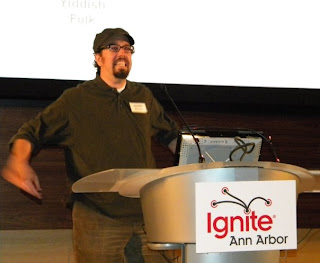While it lacks the visual appeal of Roger Bennett and Josh Kun's "And You Shall Know Us by the Trail of Our Vinyl: The Jewish Past as Told by the Records We Have Loved and Lost," it may well be the better read. Temkin is a good writer, with a gentle even prose style that compensates for the academic orientation of the thesis. Tune out the foot-notes and squint through chapter titles like "New Fusions of Yiddish and American Musical Forms, 1945-1970" and you'll find passages such as
"Today the counter-culture has turned into the old guard and one of the standard-bearers of the community. We know them as the Hasidim. While they are still concerned with the separation of the holy and profane, they understand the impact that music can have on people, and were willing to bring instrumental (and vocal) music into their community as long as it was used for holy purposes.[20]
Silence is Better than Speech
But Song is Better than Silence
—Hasidic Saying[21]"
and
"Irving Fields could play every style and tune that the consumer wanted. The Latin music was just the ritornello of his ventures that is remembered. Bagels and Bongos came out of a idea Fields had while working in Boston, and a couple different versions of the story are told. In one version, after hearing a Jewish radio program on the air the day before, he tells his drummer to play a rumba, and over this he played “Raisins and Almonds.”[2] It worked: the Jewish tam (feeling) was still there and at the same time it was danceable. The second story is that someone in the audience starting dancing a rumba to a Jewish tune that Fields was playing as a fox trot.[3] Fields changed the tune to a rumba and more people got up and danced."All in all, it's one of the best histories of American Jewish music I've read, with a focus on secular instrumental music. And it echos a point made by other cultural historians who note that while we remember the cultural peaks of our societies for their heights, it's the chaotic periods between the great peaks where the real adventures take place. Like the adventures we're having right now in Jewish music. The heights of the klezmer revival have been reached, the folk liturgical vein has been well mined, the Orthodox shiny shoe simcha music territory has been well mapped. And what's happening...an explosion in fusion forms - Jewish hip-hop, reggae, rock, punk, ambient, heavy-metal, chamber music. All what Temkin describes as "co-territorial" (in the same geographic territory) fusions. What will be the great heights that come out of this burst of creativity...don't know. But it'll be fun to listen to.








2 comments:
the trail of our vinyl book by kun and bennet is one of the most intelligent jewish books i have come across.
I'm glad you feel that way. I have mixed feelings about it. I've only read through about the first half so far but was more inspired by the breadth of their collection than the depth of their thought. I'm going to hold any more comment until I finish reading it.
Post a Comment